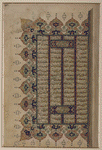| PREVIOUS | NEXT | NEW SEARCH |
Selections of Arabic, Persian, and Ottoman Calligraphy

|
Beginning of Nizami's "Iqbalnamah"
AUTHOR/CREATOR
Calligrapher: unknown
CREATED/PUBLISHED
1550-1600
NOTES
Dimensions of Written Surface: Recto: 12.1 (w) x 21 (h) cm
Dimensions of Written Surface: Verso: 11.9 (w) x 21 (h) cm
Script: nasta'liq
This illuminated folio continues the beginning of Nizami's "Iqbalnamah" (The Book of Progress), the second of two sections in the author's last book (kitab), the "Iskandarnamah" (the Book of Alexander the Great), of his "Khamsah" (Quintet). It follows the first two illuminated folios of the book (see 1-84-154.1b R & V) and provides multiple praises (subhan) of the Creator, as well as a eulogy on Muhammad, the Lord of the Messengers (dar na't-i Sayyad al-Mursilin). It is typical for Nizami to introduce every one of his five books with introductory praises of God and His Prophet before launching into a narrative.
The verso of this folio completes the first four folios of Nizami's "Iqbalnamah" (The Book of Progress), the second of two sections in the author's last book (kitab) of his "Khamsah" (Quintet). The text provides praises of God and His Prophet (see 1-84-154.1b R & V and 1-84-154.1a R), and offers some pointers about the book and its contents. The section that introduces the book's subject matter appears in an illuminated cartouche with the title (dar isharat kardan in dastan) written in white ink. In the lower corner of the folio appears the catchword (chu shah) that begins the subsequent folio, which unfortunately does not survive today.
Written during the last few decades of the 12th century A.D., Nizami's "Khamsah" consists of five books (kitab) written in rhyming distichs (mathnavi). His fifth book, the "Iskandarnamah", recounts Alexander the Great's (d. 323 B.C.) heroic exploits, battles, and journey to China, Gog and Magog, at the end of the world. It is loosely based on the epic narrative of Alexander's deeds as recounted by Firdawsi in his "Shahnamah" (Book of Kings), which may have drawn from the history of Alexander as penned down by his official biographer Callisthenes of Olynthus (c. 370-327 B.C.). Nizami's "Iskandarnamah" has been translated into English by M. S. Southgate, "Iskandarnamah: A Persian Medieval Alexander-Romance" (New York, 1978).
The illumination, white ink chapter headings, text layout, and nasta'liq script are typical of manuscripts made in the city of Shiraz during the second half of the sixteenth-century. Many Safavid Persian manuscripts at this time were produced for the domestic market and international export, rather than by royal commission.
Nine other folios from the same manuscript --mostly initial and terminal folios of the various books (kitab) from the "Khamsah" as well as one painting from the story of Laylah wa Majnun -- are held in the Library of Congress as well. These bear the same nasta'liq script at 20 lines in 4 columns/page within a similar written surface size of c. 12 (w) x 21 (h) cm. The folios are: 1-85-154.1a V, 1-85-154.1b R & V, 1-85-154.2a R & V, 1-85-154.2b R & V, and 1-86-154.123 R (painting) & V.
SUBJECT
Islamic manuscripts
Nasta'liq
Arabic script calligraphy
Illuminated Islamic manuscripts
Arabic calligraphy
Islamic calligraphy
MEDIUM
22.8 (w) x 34.4 (h) cm
CALL NUMBER
1-84-154.1a
REPOSITORY
Library of Congress, African and Middle Eastern Division, Washington, D.C. 20540
DIGITAL ID
ascs 064
http://hdl.loc.gov/loc.amed/ascs.064
| PREVIOUS | NEXT | NEW SEARCH |